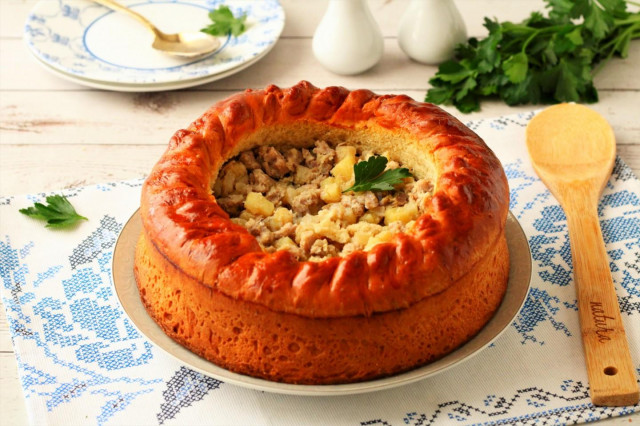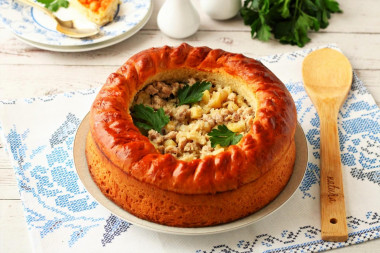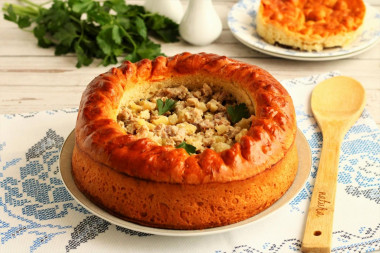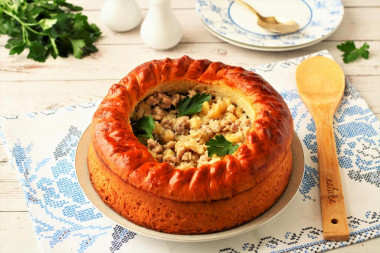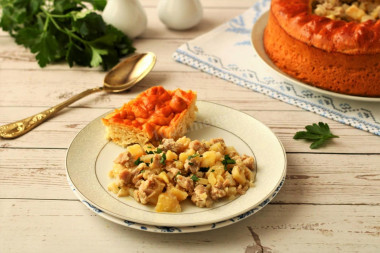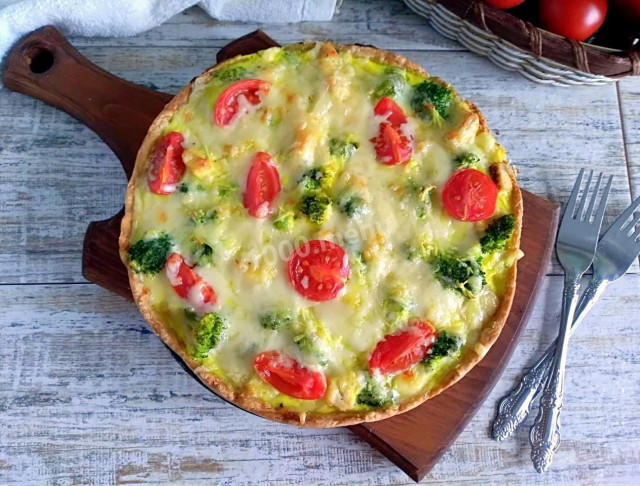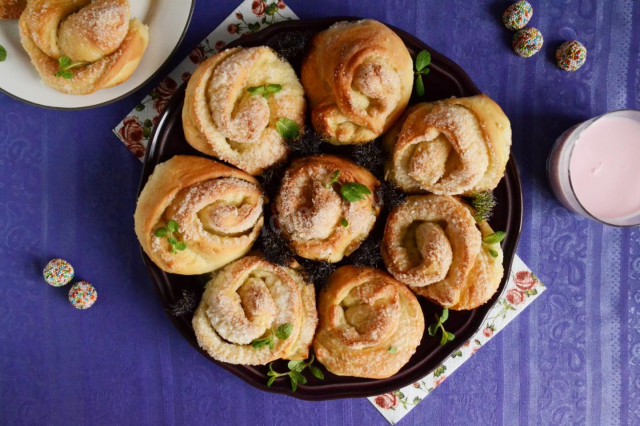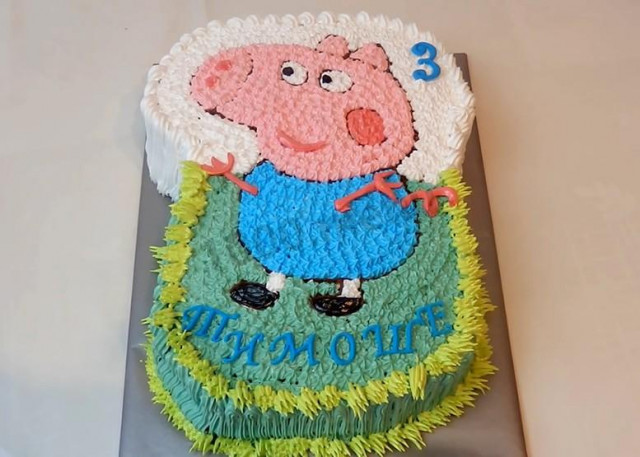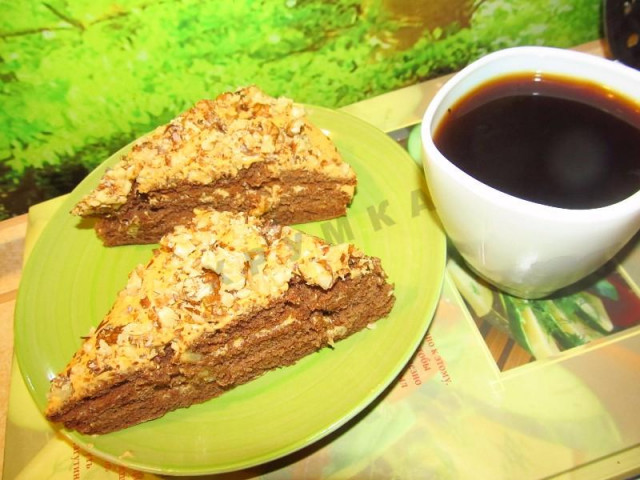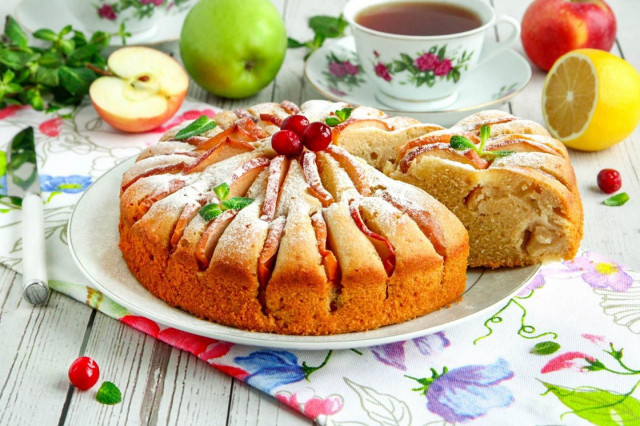Composition / ingredients
Step-by-step cooking
Step 1:
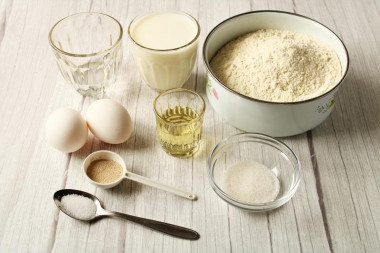
Measure out the necessary ingredients to prepare the dough for the huplu pie in Chuvash. All products should be at room temperature, this will improve the process of raising the dough. Therefore, prepare them in advance. Wheat flour is better to take the highest grade. It is most suitable for yeast baking. Fine grinding of flour allows you to get a lush and lifting dough.
Step 2:
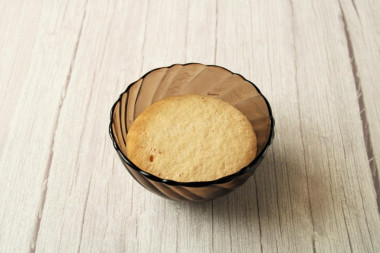
Yeast and 1 tsp sugar pour warm water, mix. Leave the yeast for 15 minutes until a foam cap forms. Keep in mind that the "caps" will require free space. So take a deep bowl or glass.
Step 3:
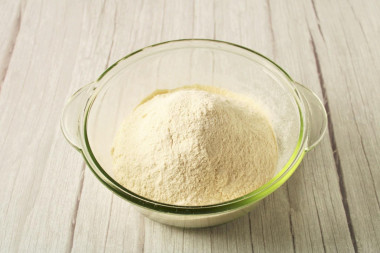
Sift the flour well through a fine sieve into a suitable container. So that the flour is not scattered on the surface, take a wider dish.
Step 4:
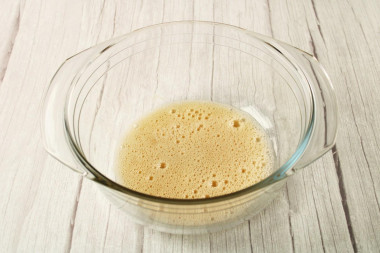
Beat the egg with salt and the remaining sugar. How to beat an egg? Here it can be done with a fork or a small whisk. A mixer or blender is not required.
Step 5:
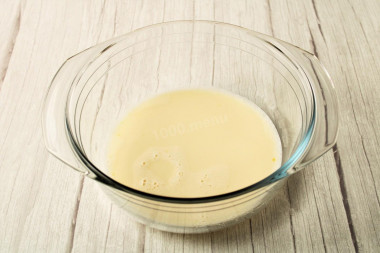
Pour in lukewarm milk, mix. Milk can be heated on the stove.
Step 6:
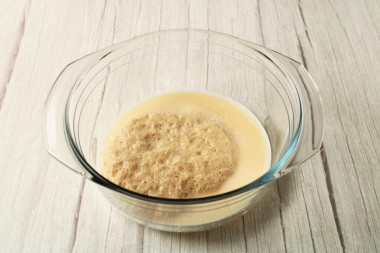
Add the yeast that has come up (on which a foam cap has appeared), mix.
Step 7:
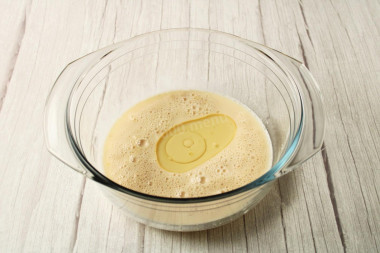
Pour in the vegetable oil, mix again.
Step 8:
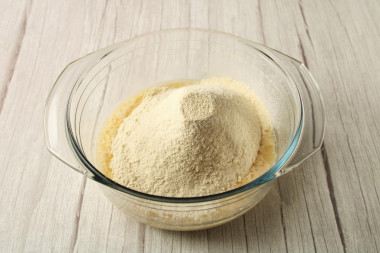
Add about 3/4 of the total flour. How to make yeast dough more lush? To do this, sift the flour through a fine sieve. You can do this immediately in a bowl with dough. It is better to take a small strainer so as not to stain the table around the dishes.
Step 9:
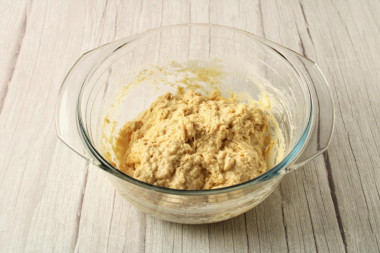
Stir. How to add flour to the dough correctly? Do not pour out all the flour at once, add it in parts. It may take a little less (or more). It depends on its quality, properties, manufacturer. At the first kneading, you should get a pretty sticky dough.
Step 10:
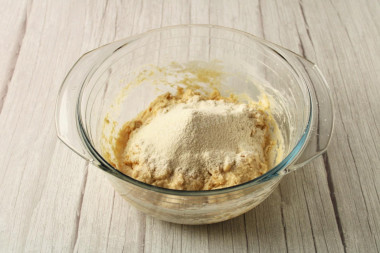
Sift the flour in small portions, stirring the dough each time. For yeast dough, it is very important not to shift the flour, otherwise it will be tight and long on the rise. So focus on the result - what should the dough be like?
Step 11:
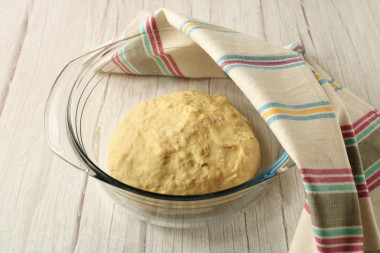
The dough should be soft, pliable, quite a bit sticky to the hands, but at the same time it should keep its shape and not spread. Leave the dough to rise in a warm place, covering it with a towel on top so that it does not wind up.
Step 12:
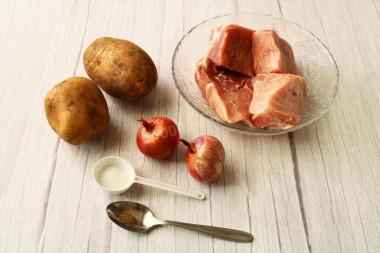
Meanwhile, get busy preparing the filling. If the meat is frozen, defrost it in advance by placing it overnight in the refrigerator on the bottom shelf. So the meat will not release a lot of juice. To make the filling more juicy and tasty, it is better to take a ham or a neck part of pork. It is better not to take a loin, the filling will be dry. But this can be compensated by adding a little butter.
Step 13:
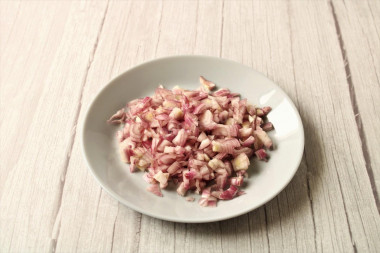
Peel the onion, wash it, cut it into small cubes. Which bow should I take? In this recipe, it doesn't really matter. As you can see, I have a red onion, but you can also take a white one.
Step 14:
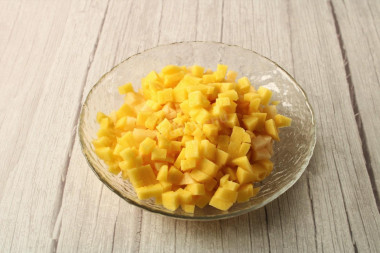
Pre-washed potatoes in running water with a brush, peel, cut into small cubes.
Step 15:
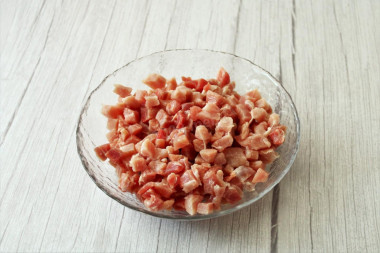
Wash the meat, dry it with a towel, and cut it into small cubes. The shape and size of the slicing ingredients for the filling should be the same. What is it for? A pie with such a filling will look more spectacular and more beautiful both in the finished form and in the cut. Plus it will be more pleasant to eat.
Step 16:
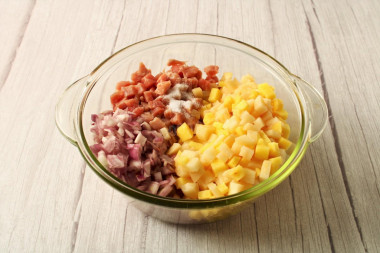
Combine meat, potatoes, onions in one bowl, season with salt and pepper. How much salt and pepper should I add? Be guided in this by your taste. Mix everything well.
Step 17:
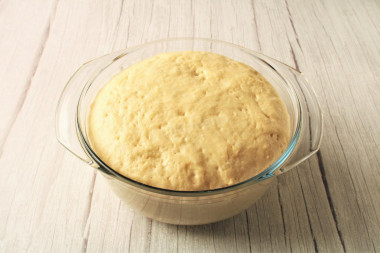
After 1 hour and 20 minutes, the dough came up well. It may take you longer/less time. The process is very dependent on the quality of yeast, air temperature, ambient sounds, etc. It happens that it takes up to three hours to rise.
Step 18:
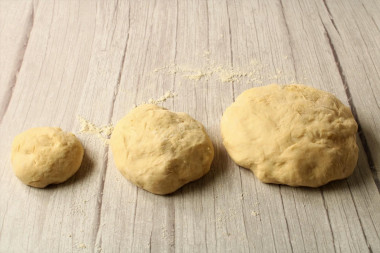
Knead the dough, put it on the table, sprinkled with flour. Divide the dough into 2/3 and 1/3. If desired, you can leave some dough to decorate the cake on top.
Step 19:
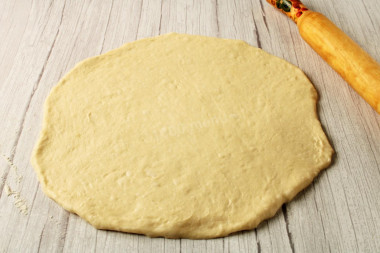
Roll out most of the dough into a round layer so that it comes to the edges of your mold. My mold diameter is 22 cm.
Step 20:
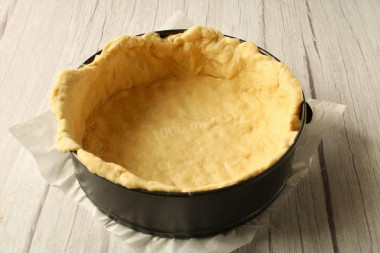
Grease the mold with vegetable oil. Transfer the dough with a rolling pin (winding it on it), carefully distribute it in the form.
Step 21:
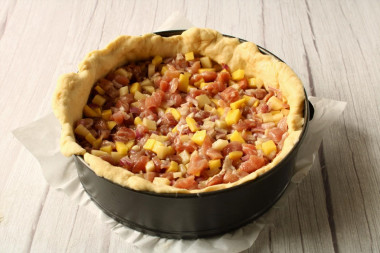
Put the filling evenly on the dough, smooth it out.
Step 22:
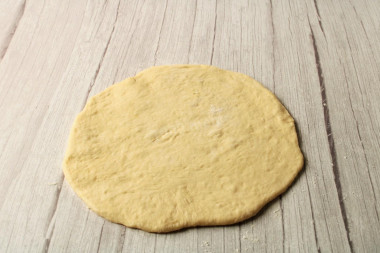
Similarly roll out the second part of the dough. Its diameter should be smaller than the first one. Ideally, it is equal to the diameter of the mold. To make the circles smoother, you can use special mats for rolling out the dough.
Step 23:
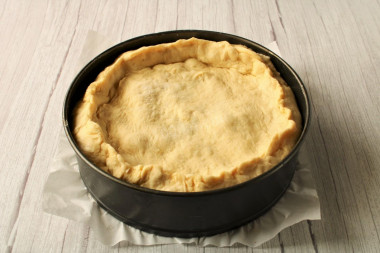
Cover the pie with rolled dough on top, pinch the edges well.
Step 24:
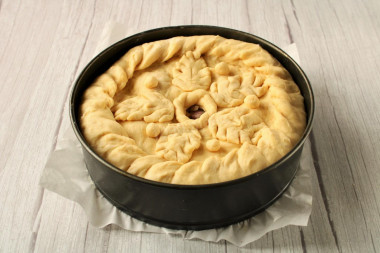
In the center of the pie, make a round hole with a diameter of at least 3 cm. If the hole is small, then during baking it may close, as the volume of the dough will increase. The hole is necessary for steam to escape and to check the filling for readiness. If desired, decorate the pie with dough patterns. I made a simple pigtail and petals.
Step 25:
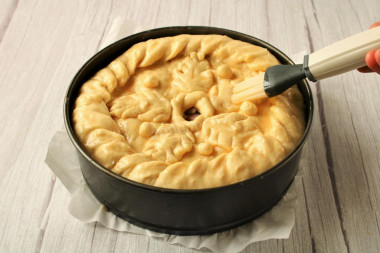
Brush the surface of the pie with beaten egg on top.
Step 26:
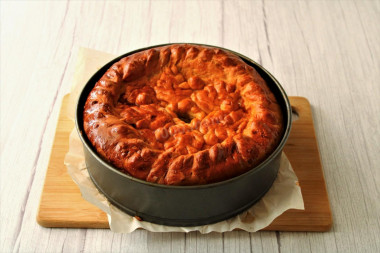
Bake the hoopla in a preheated 180C oven for about 1.5 hours. The cooking time may vary depending on the features of your oven. After 30 minutes of baking, be sure to cover the cake with foil on top so that it does not dry out and burn. Despite the fact that I was covering the pie, I still had a decent blush on it. Remove the finished pie from the oven, cover with a towel and let stand in the mold for 15 minutes. And only then take it out!
Step 27:
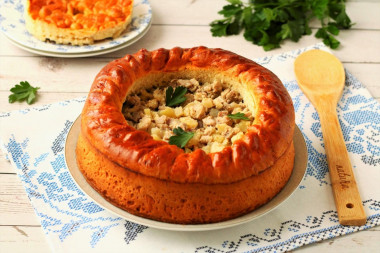
Serve the pie to the hoopla hot by cutting off the top-lid. Why cut off the top? This is done in the traditional serving of this festive Chuvash pie. Enjoy your meal!
For the filling, you can use lamb, beef, pork, poultry meat. Not only the taste of the filling, but also the cooking time will depend on the type and properties of the meat. With beef, the baking time will increase somewhat, with chicken, on the contrary, the pie will cook faster.
Traditionally, the hoopla is made round. The top of the pie is cut off, cut into pieces and eaten like bread. A juicy delicious filling is served as a second course, eating pieces of dough.
--------------------
Articles to help:
How to cook delicious in the oven according to someone else's recipes
Wheat flour. Secrets and nuances of use
Caloric content of the products possible in the composition of the dish
- Ripe potatoes - 80 kcal/100g
- Baked potatoes - 70 kcal/100g
- Mashed potatoes - 380 kcal/100g
- Boiled potatoes - 82 kcal/100g
- Potatoes in uniform - 74 kcal/100g
- Fried potatoes - 192 kcal/100g
- Whole cow's milk - 68 kcal/100g
- Milk 3.5% fat content - 64 kcal/100g
- Milk 3.2% fat content - 60 kcal/100g
- Milk 1.5% fat content - 47 kcal/100g
- Concentrated milk 7.5% fat content - 140 kcal/100g
- Milk 2.5% fat content - 54 kcal/100g
- Chicken egg - 157 kcal/100g
- Egg white - 45 kcal/100g
- Egg powder - 542 kcal/100g
- Egg yolk - 352 kcal/100g
- Ostrich egg - 118 kcal/100g
- Pork fat - 333 kcal/100g
- Pork meat - 357 kcal/100g
- Pork - low-fat roast - 184 kcal/100g
- Pork chop on a bone - 537 kcal/100g
- Pork - schnitzel - 352 kcal/100g
- Pork shoulder - 593 kcal/100g
- Boar's leg - 113 kcal/100g
- Pork - 259 kcal/100g
- Ground black pepper - 255 kcal/100g
- Granulated sugar - 398 kcal/100g
- Sugar - 398 kcal/100g
- Vegetable oil - 873 kcal/100g
- Salt - 0 kcal/100g
- Water - 0 kcal/100g
- Onion - 41 kcal/100g
- Wheat flour - 325 kcal/100g
- Dry yeast - 410 kcal/100g

